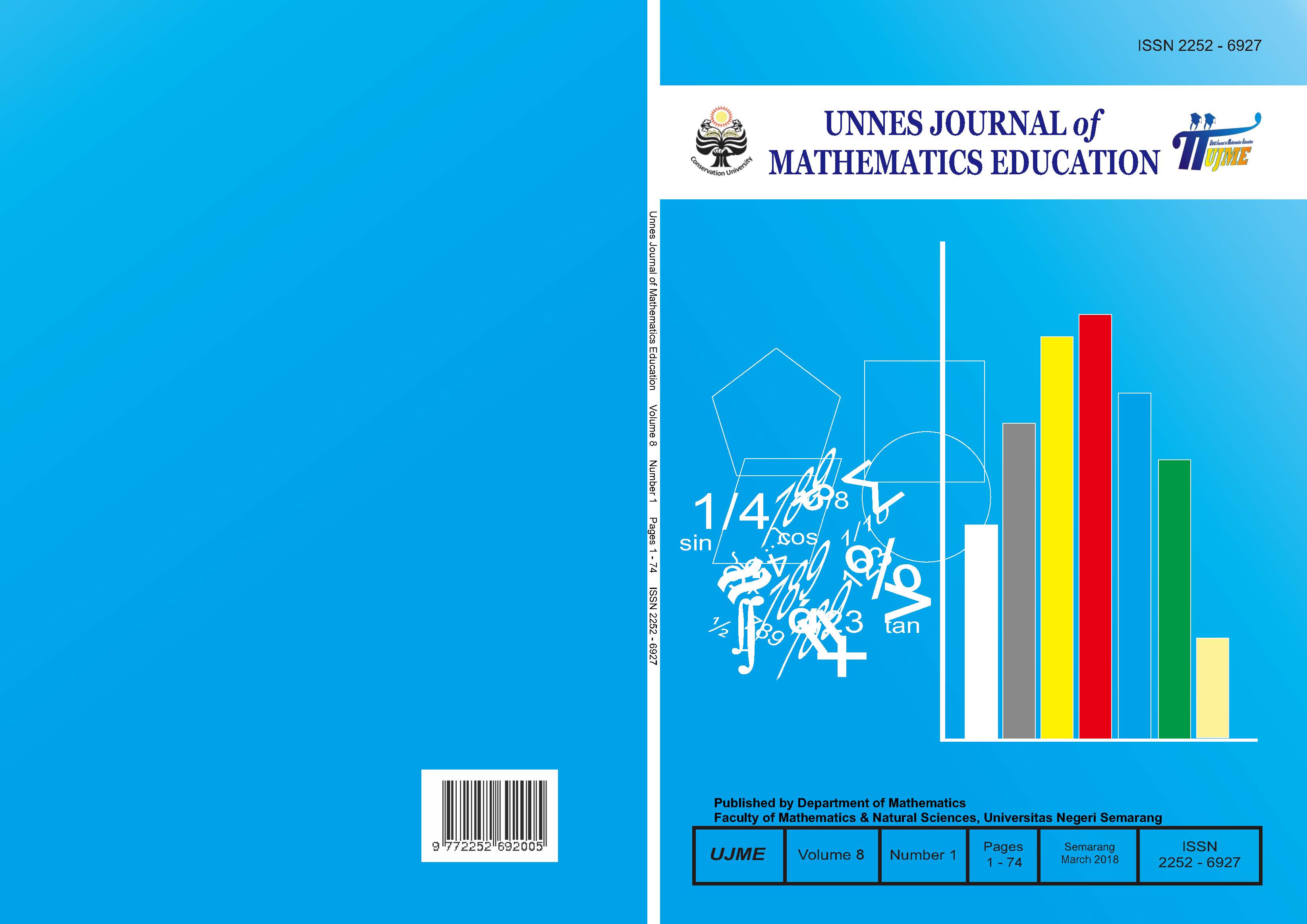The mathematical creative thinking ability viewed from learning interest in eleventh grade of vocational high school by using treffinger model assisted by problem card
##plugins.themes.academic_pro.article.main##
Abstract
This study aimed to find out (1) whether the students’ mathematical creative thinking ability with Treffinger learning model assisted by problem cards could achieve classical completeness or not, (2) whether the average of students’ mathematical creative thinking ability with Treffinger learning model assisted by problem card can reach the Minimum Mastery Learning Criteria or KKM, (3) whether students' mathematical creative thinking ability with Treffinger's learning model assisted by problem cards was better than students’ with PBL learning model, and (4) the analysis of students' mathematical creative thinking ability in terms of students' learning interests. This research was a mixed method research. The population of this research was XI grade students of State Vocational High School 2 Rembang. The subjects of this research were selected by using random sampling techniqu. Then, XI grade of shipping engineering class B as class experiment class XI A as PBL learning class. The data collection covered method tests, questionnaires, observaÂtions, and interviews. Afterwards, the result showed that that: (1) the mathematical creative thinking ability of students in Treffinger learning assisted by problem cards achieved the classical completeness, (2) the students’ mathematical creative thinking ability in Treffinger learning assisted by problem card achieved the Minimum Mastery Learning Criteria, (3) the students’ creative thinking ability with Treffinger learning model assisted by problem card was better than students with PBL learning model, and (4) the students’ mathematical creative thinking with high interest in learning was better than students’ with the low learning interest.
##plugins.themes.academic_pro.article.details##
References
Barak, M. & Y. Doppelt. (2000). Using Portfolio to Enhance Creative Thinking.
The Journal of Technology Studies Summer-Fall 2000, 26(2): 16-25.
Career Center Maine Department of Labor. (2004). Today’s Work Competence in
Maine.
Kpolovie, P.J., A.I. Joe, & T. Okoto. (2014). Academic Achievement Predictiont: Role of Interest in Learning and Attitude toward School. International Journal of Humanities Social Sciences and Education (IJHSSE), 1(11):73-100.
Lestari, I. (2013). Pengaruh Waktu Belajar dan Minat Belajar terhadap Hasil Belajar Matematika. Jurnal Formatif, 3(2): 115- 125.
Mustaqim, B., Riyadi, & I. Sujadi. (2013). Eksperimentasi Model Pembelajaran Kooperatif Tipe Think Pair Share (TPS). Jurnal FKIP UNS, 1(3).
Peraturan Menteri Pendidikan dan Kebudayaan Republik Indonesia Nomor 21 tahun 2016 tentang Standar Isi Pendidikan Dasar dan Menengah (Decree of The Indonesian Minister of Education and Culture Number 21, 2016)
Potur, A. A. & O. Barkul. (2009). Gender and Creative Thinking in Education: A Theoretical and Experimental Overview. University Faculty of Architecture Journal, 6(2): 44-57.
Pramadita, A.A., Mashuri, & R. Arifudin. (2013). Keefektifan Model Pembelajaran Course Review Horray terhadap Hasil Belajar dan Minat Belajar. Unnes Journal of Mathematics Education (UJME), 2(2).
Rohaeti. (2013). Penerapan Model Treffinger pada Pembelajaran Matematika untuk Meningkatkan Kemampuan Berpikir Kreatif Siswa SMP. Jurnal Online Pendidikan Matematika Kontemporer.
Siagian, R. (2012). Pengaruh Minat dan Kebiasaan Belajar Terhadap Prestasi Belajar Matematika. Jurnal Formatif, 2(2): 122-131
Silver, E.A. (1997). Fostering Creativity through Instruction Rich in Mathematical Problem Solving and Thinking in Problem Posing. Analyses, 29(3): 75-80.
Siswono, T .E.Y. (2007). Konstruksi Teoritik Tentang Tingkat Berpikir Kreatif Siswa dalam Matematika. Jurnal Pendidikan, Forum Pendidikan dan Ilmu
Pengetahuan, 2(4).
Sugiyono. (2015). Metode Penelitian Pendidikan. Bandung : Alfabeta.
Triwibowo, Z., N.K. Dwidayanti, & Sugiman. 2017. Analisis Kemampuan Berpikir Kreatif Matematis Ditinjau dari Gaya Belajar Siswa Kelas VII Melalui Model Pembelajaran Treffinger dengan Pendekatan Open-Ended. Unnes Journal of Mathematics Education (UJME), 6(3).
